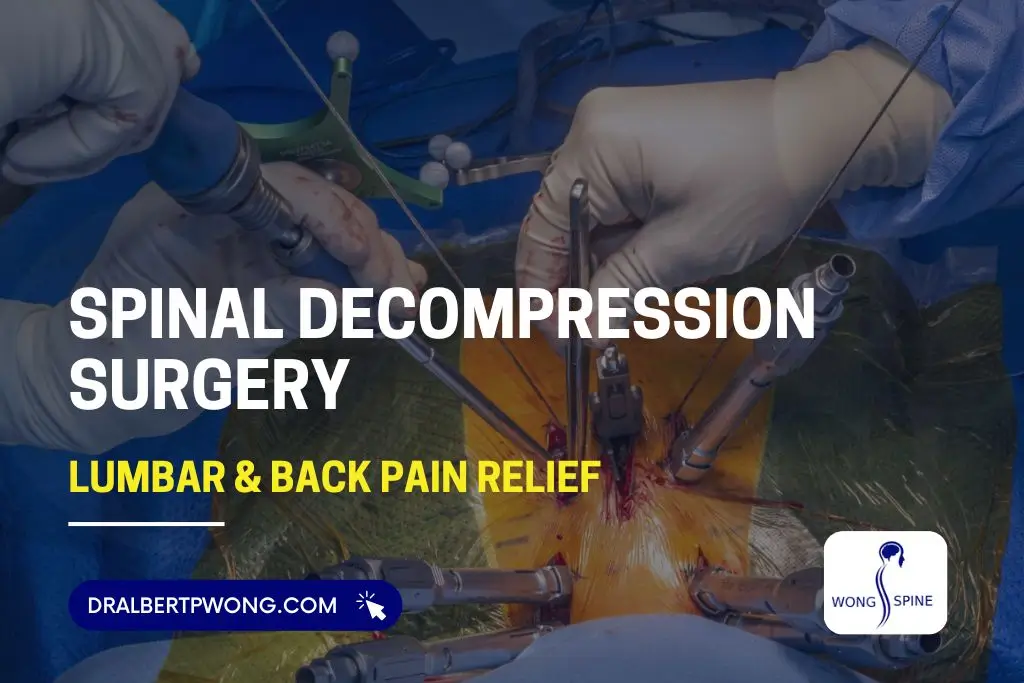Overview
Spinal decompression surgery relieves pressure on the spinal cord or nerves caused by conditions such as herniated discs, spinal stenosis, or bone spurs. This pressure can lead to back or neck pain, numbness, tingling, or weakness in the arms or legs.
The procedure’s main goal is to reduce nerve compression, ease pain, and restore function. By removing or reshaping parts of bone or disc material, the surgeon creates more space for the spinal nerves.
What Is Spinal Decompression Surgery?
Spinal decompression surgery is performed to relieve pressure on the spinal cord or nerve roots caused by narrowing of the spinal canal or disc material pressing on nerves. The procedure removes or trims parts of bone, disc, or ligaments to create more space for the nerves, reducing pain and restoring normal nerve function.
It is commonly recommended when nonsurgical treatments such as physical therapy, medications, or injections fail to provide relief. The goal is to reduce nerve irritation, improve mobility, and prevent further nerve damage.
Types of Spinal Decompression Surgeries
Several surgical procedures are used to decompress the spine, depending on the location and cause of nerve compression:
- Laminectomy: Removes the lamina, the back portion of the vertebra, to enlarge the spinal canal and relieve pressure on the spinal cord or nerves.
- Laminotomy: Removes a smaller part of the lamina to relieve localized pressure while preserving more of the bone structure.
- Discectomy / Microdiscectomy: Removes part of a herniated or bulging disc that is pressing on a nerve. A microdiscectomy uses a smaller incision and magnification tools for precision.
- Foraminotomy: Enlarges the nerve root exit (foramen) to create more space for nerves leaving the spinal canal.
Indications for Decompression Surgery
Spinal decompression surgery is recommended for patients with nerve compression that causes persistent pain or neurological symptoms. Common indications include:
- Spinal stenosis: Narrowing of the spinal canal due to bone overgrowth or thickened ligaments.
- Herniated disc: Disc material pressing on a spinal nerve.
- Bone spurs (osteophytes): Overgrowths that compress nerves.
- Degenerative disc disease: Breakdown of spinal discs leading to nerve irritation.
- Spondylolisthesis: Slippage of one vertebra over another, causing nerve pressure.
Surgery is considered when symptoms such as pain, weakness, or numbness interfere with daily activities and do not improve with conservative care.
How Serious Is Spinal Decompression Surgery?
Spinal decompression surgery is considered a major procedure because it involves operating near the spinal cord and nerve roots. While many patients benefit from significant pain relief and improved mobility, the surgery carries inherent risks.
The seriousness depends on factors such as the type of decompression, the spinal level involved, the patient’s overall health, and whether the procedure is performed using a minimally invasive or open approach.
Key considerations include:
- Risk of complications: Possible issues include infection, bleeding, nerve injury, or blood clots.
- Recovery time: Recovery can range from a few weeks for minimally invasive procedures to several months for more extensive surgery.
- Impact on daily life: Patients may have temporary restrictions on bending, lifting, or twisting until healing is complete.
- Potential benefits vs. risks: While serious, the surgery often provides long-term relief for nerve-related pain, improves mobility, and enhances quality of life when conservative treatments have failed.
A thorough evaluation by a spine specialist helps determine whether the potential benefits outweigh the risks and ensures the procedure is appropriate for the patient’s condition.
Lumbar Decompression Surgery
Overview of Lumbar Decompression
Lumbar decompression surgery targets nerve compression in the lower back (lumbar spine), which can cause pain, numbness, tingling, or weakness in the legs. Common causes include herniated discs, spinal stenosis, bone spurs, or spondylolisthesis. The goal of the surgery is to relieve pressure on the affected nerves, restore normal function, and improve mobility.
Procedure for Lumbar Decompression Surgery
Lumbar decompression can be performed using various techniques depending on the patient’s condition:
- Laminectomy: Removal of the lamina to enlarge the spinal canal and relieve nerve compression.
- Laminotomy: Partial removal of the lamina to relieve pressure on specific nerves while preserving spinal stability.
- Discectomy / Microdiscectomy: Removal of herniated disc material pressing on nerve roots, often performed through a small incision with a microscope.
- Foraminotomy: Widening the foramen, the bony opening where the nerve exits the spinal canal, to relieve nerve compression.
The procedure can be performed using minimally invasive or traditional open surgery techniques, depending on the complexity of the condition. Minimally invasive methods often reduce hospital stay, blood loss, and recovery time.
Risks of Lumbar Decompression
While generally effective, lumbar decompression carries potential risks, including:
- Infection at the surgical site.
- Bleeding.
- Nerve injury causing numbness or weakness.
- Blood clots.
- Persistent pain if nerve compression is not fully relieved.
- Spinal instability in rare cases, which may require additional surgery.
Surgeons carefully evaluate each patient to minimize risks and provide the best chance for pain relief and improved function.
Recovery Time After Spinal Decompression Surgery
Immediate Post-Spine Surgery
After surgery, patients may stay in the hospital from a few hours to several days depending on the procedure. Medical staff monitor vital signs, manage pain, and check for complications. Early walking is encouraged to prevent blood clots and support healing.
Rehabilitation and Physical Therapy
Physical therapy is a critical part of recovery. Exercises focus on strengthening the back and core muscles, improving flexibility, and teaching proper body mechanics to protect the spine. Rehabilitation helps restore mobility and reduces the risk of future injuries.
At-Home Recovery
Recovery continues at home for several weeks to months. Patients are advised to:
- Avoid heavy lifting, bending, or twisting.
- Gradually increase activity levels.
- Follow all postoperative instructions provided by the surgeon.
- Attend follow-up appointments to monitor healing and progress.
Expected Timeline
- First few days: Pain management and gentle movement.
- Weeks 1–4: Gradual return to light daily activities.
- Weeks 4–12: Increased physical therapy intensity, improved mobility.
- 3–6 months: Full recovery for most patients, though some may require longer depending on the procedure and individual health.
Following post-surgery guidelines and staying active within recommended limits is key to a successful recovery and long-term relief.
Minimally Invasive vs. Traditional Lumbar Decompression Surgery
Minimally Invasive Lumbar Decompression (MIS)
Minimally invasive lumbar decompression uses small incisions and specialized instruments to access the spine through or between muscles. A microscope or camera guides the surgeon to remove disc material or bone causing nerve compression.
Benefits of MIS:
- Smaller incisions and less tissue damage
- Reduced blood loss
- Shorter hospital stay
- Faster recovery
- Lower risk of infection
Traditional Open Lumbar Decompression
Open surgery uses a larger incision for direct visualization of the spine. It is required for complex cases, multiple-level decompression, or significant spinal instability.
Considerations for open surgery:
- Longer recovery.
- Greater postoperative pain.
- Increased blood loss.
- Needed for severe or multi-level conditions.
The choice between minimally invasive and open surgery depends on the patient’s anatomy, nerve compression extent, and surgeon’s assessment. Both methods relieve nerve pressure and restore function.
Risks and Benefits of Spinal Decompression Surgery
Potential Benefits
Spinal decompression surgery can provide significant improvements for patients with nerve compression. Key benefits include:
- Relief from back or leg pain caused by nerve pressure.
- Improved mobility and function.
- Reduction or elimination of numbness, tingling, or weakness.
- Decreased reliance on pain medications.
- Enhanced quality of life and ability to perform daily activities.
Potential Risks
As with any surgery, spinal decompression carries risks. Common risks include:
- Infection at the surgical site.
- Excessive bleeding.
- Nerve injury, potentially causing numbness, weakness, or persistent pain.
- Blood clots.
- Spinal instability or recurrence of symptoms.
- Rare complications related to anesthesia.
A spine specialist evaluates each patient to weigh risks and benefits. Proper surgical planning and following post-operative instructions reduce complications.
Frequently Asked Questions About Spinal Decompression Surgery
Is spinal decompression surgery right for me?
Surgery is considered when conservative treatments like physical therapy, medications, or injections fail. It is recommended for patients with nerve compression causing persistent pain, numbness, weakness, or limited mobility. A spine specialist evaluates whether the benefits outweigh the risks.
How long does recovery take?
Recovery depends on the type and extent of surgery. Minimally invasive procedures may allow light activity within a few weeks, while open surgery may require several months. Physical therapy is important to restore strength and mobility.
Can I improve my surgical outcome?
Yes. Patients can improve outcomes by:
- Maintaining a healthy weight to reduce spine stress
- Avoiding smoking and nicotine, which slow healing
- Managing chronic conditions such as diabetes or high blood pressure
- Staying active with gentle exercise before and after surgery
What are the main risks?
Risks include infection, bleeding, nerve injury, blood clots, or persistent pain. The surgeon will explain which risks apply to the patient’s procedure.
How do I choose the right surgeon?
Consider the surgeon’s experience with spinal decompression, board certification, communication style, hospital affiliation, access to advanced surgical tools, and openness to second opinions.
Treatment at Spine Wong
At Spine Wong in Los Angeles and Beverly Hills, Albert Wong, MD, evaluates and treats spinal conditions that may require decompression surgery. Patients receive a thorough assessment, explanation of treatment options, and a personalized surgical plan.
The clinic performs procedures including lumbar decompression, microdiscectomy, and minimally invasive spine surgery. Patients receive clear pre- and post-operative instructions, rehabilitation guidance, and follow-up care to support a smooth recovery.
Spine Wong aims to relieve pain, restore function, and help patients safely return to daily activities.
Important: This information is for educational purposes only and does not replace professional medical advice. Consult a qualified healthcare provider for diagnosis and treatment specific to your condition.






